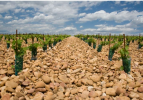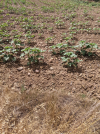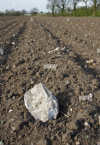- Time of past OR future Camino
- frances
-
For 2024 Pilgrims: €50,- donation = 1 year with no ads on the forum + 90% off any 2024 Guide. More here.
(Discount code sent to you by Private Message after your donation) -
 ⚠️ Emergency contact in Spain - Dial 112 and AlertCops app. More on this here.
⚠️ Emergency contact in Spain - Dial 112 and AlertCops app. More on this here. -
Get your Camino Frances Guidebook here.
Search 69,459 Camino Questions
You are using an out of date browser. It may not display this or other websites correctly.
You should upgrade or use an alternative browser.
You should upgrade or use an alternative browser.
Fields of rocks
- Thread starter puttster
- Start date
...and ship it to Santiago for storage. You pick it up once in Santiago. Service offered by Casa Ivar (we use DHL for transportation).
- Time of past OR future Camino
- Us:Camino Frances, 2015 Me:Catalan/Aragonese, 2019
They do act a bit like mulch keeping the water underneath and in their shade from evaporating as fast as in bare soil.
A couple of our daily walks in New England take us past corn fields where it looks like the pebbles in the picture you sent are the seeds for the Yankee rocks grown by the local farmers for use in their stone fences.
A couple of our daily walks in New England take us past corn fields where it looks like the pebbles in the picture you sent are the seeds for the Yankee rocks grown by the local farmers for use in their stone fences.
Glenshiro
Veteran Member
- Time of past OR future Camino
- Le Puy - SdC, Podiensis, Frances, Invierno 2012-23
Most of Spain has poor soil, sandy and full of stones. Removing them is very labour - intensive, and ultimately fruitless as the earth will constantly bring fresh layers to the surface. Spanish farmers have learned to live with them.
€2,-/day will present your project to thousands of visitors each day. All interested in the Camino de Santiago.
The first edition came out in 2003 and has become the go-to-guide for many pilgrims over the years. It is shipping with a Pilgrim Passport (Credential) from the cathedral in Santiago de Compostela.
Jeff Crawley
Veteran Member
- Time of past OR future Camino
- A "Tourigrino" trip once Covid has passed, so 2023
- Time of past OR future Camino
- frances
If the rocks constantly rise up to the surface and don't get removed then the rocks in my pic may have been there for many, maybe even hundreds, of years? Dang.
LesR
Active Member
- Time of past OR future Camino
- Camino Frances 2017, 2018; Camino Portuguese 2019
possibly still there because it is impractical and uneconomic to remove them... and ploughing machinery can be hard-surfaced to better deal with abrasive soils.Walking along the CF I see so many of the farming fields are full of rocks. It seems to me they would be pretty tough on the equipment so I wonder if there is a good reason for leaving them in the fields.
3rd Edition. More content, training & pack guides avoid common mistakes, bed bugs etc
- Time of past OR future Camino
- VdlP(2012) Madrid(2014)Frances(2015) VdlP(2016)
VdlP(2017)Madrid/Sanabres/Frances reverse(2018)
where was the picture taken, puttster?Walking along the CF I see so many of the farming fields are full of rocks. It seems to me they would be pretty tough on the equipment so I wonder if there is a good reason for leaving them in the fields.
bearwithme
Member
- Time of past OR future Camino
- October, 2014
September, "2017"
When I walked the Camino Frances in 2017, I referred to them as "big potatoes". Pretty hard to walk on them
- Time of past OR future Camino
- 2017 Frances from Saria
2018 Finnisterre
Robert Frost ID’d the best use for the rocks.
Very light, comfortable and compressible poncho. Specially designed for protection against water for any activity.
Our Atmospheric H30 poncho offers lightness and waterproofness. Easily compressible and made with our Waterproof fabric, its heat-sealed interior seams guarantee its waterproofness. Includes carrying bag.
€60,-
Our Atmospheric H30 poncho offers lightness and waterproofness. Easily compressible and made with our Waterproof fabric, its heat-sealed interior seams guarantee its waterproofness. Includes carrying bag.
€60,-
MichelleElynHogan
Veteran Member
This is a job for an agriculturist. To improve soil like this, it can take generations. The only way to do it is to either remove the stones and /or add soil. To add soil, there has to be a place where top soil is not required, then move and spread it. The other option is to introduce plant matter, roll it in and allow it to compost, add to the soil that is there. This is one reason why fields will lay fallow, (unplanted with harvestable produce), for up to several years, so, when tilled again, all plant life is worked into the soil to add to its volume as well as increase nutrients. Adding manure and all other fertilizers is a given. Removing stones can be done by machinery but is specialized and expensive.
Mention was made that moisture may be retained under stones. Well, stones heat up, being solid, much faster than soil, so, any soil will dry out faster because of the rocks and stones.
Mention was made that moisture may be retained under stones. Well, stones heat up, being solid, much faster than soil, so, any soil will dry out faster because of the rocks and stones.
- Time of past OR future Camino
- Mozarabe Feb 24
I agree with all, except the last sentence. Turning over largish stones in my field this morning, the soil underneath was definitely damper than that to the side. How labour intensive it would be to remove those in the picture and next year, more would be ploughed up.This is a job for an agriculturist. To improve soil like this, it can take generations. The only way to do it is to either remove the stones and /or add soil. To add soil, there has to be a place where top soil is not required, then move and spread it. The other option is to introduce plant matter, roll it in and allow it to compost, add to the soil that is there. This is one reason why fields will lay fallow, (unplanted with harvestable produce), for up to several years, so, when tilled again, all plant life is worked into the soil to add to its volume as well as increase nutrients. Adding manure and all other fertilizers is a given. Removing stones can be done by machinery but is specialized and expensive.
Mention was made that moisture may be retained under stones. Well, stones heat up, being solid, much faster than soil, so, any soil will dry out faster because of the rocks and stones.
- Time of past OR future Camino
- "2013"; "2014"; "2015"; "2016"; "2018 Baztan"
2018 arrive Tuesday 18th Sept St. JpdeP.
The stones/rocks act as storage heaters. They bring heat into the soil and encourage growth. As I heard it.
Joe
Joe
€2,-/day will present your project to thousands of visitors each day. All interested in the Camino de Santiago.
Migueldc
Miguel
- Time of past OR future Camino
- Frances, 2014
Portugés Coastal from Porto, May 2016
I agree with all, except the last sentence. Turning over largish stones in my field this morning, the soil underneath was definitely damper than that to the side. How labour intensive it would be to remove those in the picture and next year, more would be ploughed up.
Migueldc
Miguel
- Time of past OR future Camino
- Frances, 2014
Portugés Coastal from Porto, May 2016
Wine from rocks?
Monastrell / Mourvèdre vines typical of arid areas is eastern Spain eg Jumilla.
Image from Winetraveler
Winetraveler • Wine Vacation Itineraries & Insider Travel Tips

Monastrell / Mourvèdre vines typical of arid areas is eastern Spain eg Jumilla.
Image from Winetraveler
Winetraveler • Wine Vacation Itineraries & Insider Travel Tips

- Time of past OR future Camino
- frances
Picture is one of several taken on the meseta among bean, wheat sunflower and other plants. I see what you're thinking - maybe they are put or kept intentionally, to keep the soil from blowing away in the wind.
Also, I wonder if the rocks add trace amounts of minerals to the soil every time it rains. Or like OBJ says, maybe they retain heat meseta gets into the 40s at night in June.
I find it hard to believe they cannot be removed with some pretty simple equipment -dozens of implements for this purpose can be seen with a simple search - so there must be a benefit of some kind.
Also, I wonder if the rocks add trace amounts of minerals to the soil every time it rains. Or like OBJ says, maybe they retain heat meseta gets into the 40s at night in June.
I find it hard to believe they cannot be removed with some pretty simple equipment -dozens of implements for this purpose can be seen with a simple search - so there must be a benefit of some kind.
Last edited:
Technical backpack for day trips with backpack cover and internal compartment for the hydration bladder. Ideal daypack for excursions where we need a medium capacity backpack. The back with Air Flow System creates large air channels that will keep our back as cool as possible.
€83,-
€83,-
Philtration
Active Member
- Time of past OR future Camino
- CF 2021, 2023
It's believed rocks can add trace minerals to the soil which affect the terroir and the ultimate flavor of wines produced. Some of the best wines come from rocky soil.Wine from rocks?
Monastrell / Mourvèdre vines typical of arid areas is eastern Spain eg Jumilla.
Image from Winetraveler
Winetraveler • Wine Vacation Itineraries & Insider Travel Tips
View attachment 129946
MichelleElynHogan
Veteran Member
Yes, large, deep stone will maintain some moisture, not like in the Author supplied photo, purely due to their depth, inability of the Sun to heat the stone to that depth, but large stones are plow breakers and crops would work harder to find that moisture deeper down.I agree with all, except the last sentence. Turning over largish stones in my field this morning, the soil underneath was definitely damper than that to the side. How labour intensive it would be to remove those in the picture and next year, more would be ploughed up.
- Time of past OR future Camino
- Mozarabe Feb 24
Agree, I don't have a plough, so no problem there, mainly grazing.
Yes, large, deep stone will maintain some moisture, not like in the Author supplied photo, purely due to their depth, inability of the Sun to heat the stone to that depth, but large stones are plow breakers and crops would work harder to find that moisture deeper dow
Very light, comfortable and compressible poncho. Specially designed for protection against water for any activity.
Our Atmospheric H30 poncho offers lightness and waterproofness. Easily compressible and made with our Waterproof fabric, its heat-sealed interior seams guarantee its waterproofness. Includes carrying bag.
€60,-
Our Atmospheric H30 poncho offers lightness and waterproofness. Easily compressible and made with our Waterproof fabric, its heat-sealed interior seams guarantee its waterproofness. Includes carrying bag.
€60,-
Most read last week in this forum
I think I messed up my stages. Following Brierly now after being off stage during the busy sections. Brierly has a stage from Molinaseca to villafranca del Bierzo. And then one potentially...
A local Navarra website has reported the death of a 61 year old German peregrina this morning in Zuriain. The cause appears to have been cardiac arrest. The third death of a pilgrim in Navarra in...
We’re currently on the Frances. We’re walking from SJPDP. We’re looking at our projected dates for Sarria to Santiago. When we try to find lodging it all looks sold out on booking.com. What...
I just got an email that the train from Bayonne to St Jean tonight is canceled. Anyone else see this?
Hi - I am currently on the Via Podiensis and in a few weeks will be arriving in SJPP and then continuing on the Frances for a bit.
I have never been to SJPP before and am wondering if it is worth...
So just leaving Sarria, after crossing the little stone bridge Ponte de Aspera at the train tracks there are 2 mojons pointing different directions. It was fun to watch the confusion of the shiny...
Similar threads
- Replies
- 4
- Views
- 780
❓How to ask a question
How to post a new question on the Camino Forum.
Similar threads
-
List of Holidays or days of heavier use on CF
- Started by NerdGjerd
- Replies: 4
-
Palace of the Kings of Navarre, Olite
- Started by isabeau
- Replies: 10
-
LIVE from the Camino Day 5 of the Frances!
- Started by SFHiker
- Replies: 4
-
Most downloaded Resources
-
“All” Albergues on the Camino Frances in one pdf“All” Albergues on the Camino Frances in one pdf
- ivar
- Updated:
-
A selection of favorite albergues on the Camino FrancésFavorite Albergues along the Camino Frances
- Ton van Tilburg
- Updated:
-
Profile maps of all 34 stages of the Camino FrancesProfile maps of all 34 stages of the Camino Frances
- ivar
- Updated:

















